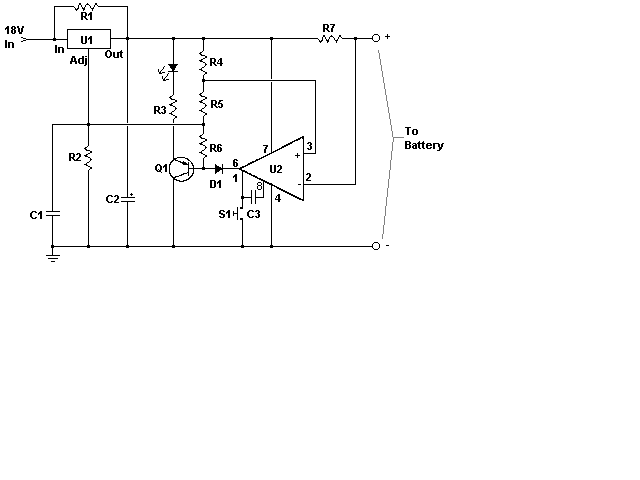
Car Battery Charger
This charger will quickly and easily charge most any lead acid battery. The charger delivers full current until the current drawn by the battery falls to 150 mA. At this time, a lower voltage is applied to finish off and keep from over charging. When the battery is fully charged, the circuit switches off and lights a LED, telling you that the cycle has finished.
Schematic
Parts
R1__________500 Ohm 1/4 W Resistor
R2__________3K 1/4 W Resistor
R3__________1K 1/4 W Resistor
R4__________15 Ohm 1/4 W Resistor
R5__________230 Ohm 1/4 W Resistor
R6__________15K 1/4 W Resistor
R7__________0.2 Ohm 10 W Resistor
C1__________0.1uF 25V Ceramic Capacitor
C2__________1uF 25V Electrolytic Capacitor
C3__________1000pF 25V Ceramic Capacitor
D1__________1N457 Diode
Q1__________2N2905 PNP Transistor
U1__________LM350 Regulator
U2__________LM301A Op Amp
S1__________Normally Open Push Button Switch
MISC________Wire, Board, Heatsink For U1, Case, Binding Posts For Output
1. The circuit was meant to be powered by a power supply, which is why there is no transformer, rectifier, or filter capacitors on the schematic. There is no reason why you cannot add these.
2. A heatsink will be needed for U1.
3. To use the circuit, hook it up to a power supply/plug it in. Then, connect the battery to be charged to the output terminals. All you have to do now is push S1 (the "Start" switch), and wait for the circuit to finish.
4. The first time you use the circuit, you should check up on it every once and a while to make sure that it is working properly and the battery is not being over charged.